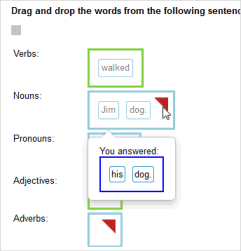How questions are graded
Generally a response to an assignment question is correct or incorrect. However, your instructor can allow you to earn partial credit for a question that has multiple parts. If partial credit is not available, you receive the question's full point value if your answer is completely correct; otherwise the question is scored as incorrect.
When partial credit is available, a question can be scored as correct ![]() , partially correct
, partially correct ![]() , or incorrect
, or incorrect ![]() . Correct means you completed all question parts correctly; incorrect means you did not complete any correctly.
. Correct means you completed all question parts correctly; incorrect means you did not complete any correctly.
When the scoring allows for partial credit, each question part is scored separately. Partial credit is awarded when at least one answer is correct and at least one is incorrect. The calculation for the partial credit is based on a question's point value, the number of targets, and number of answers.
When you review your answers for drag-and-drop and fill-in-the-blank questions, they display the correct answers. If any of your answers were incorrect, the answer displays the correct answer and a red triangle  in the upper-right corner of the answer. Point to the red triangle to display the answer that you entered.
in the upper-right corner of the answer. Point to the red triangle to display the answer that you entered.
Here's an example of a student's incorrect answers to a drag-and-drop question. The correct answers for Nouns are Jim and dog. The student points to the red triangle to see that the answers given were his and dog.

This is another example showing an incorrect answer in a fill-in-the-blank question. The correct answer is talked but the student entered had talked.

You'll also see the red triangle for any incorrect answers in some math questions, such as this one.

See also: